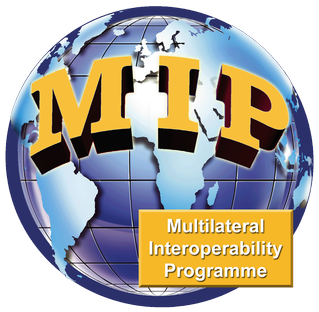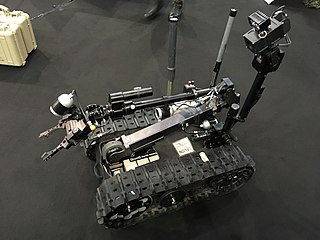
The North Atlantic Treaty Organization, also called the North Atlantic Alliance, is an intergovernmental military alliance between 30 member states – 28 European and two North American. Established in the aftermath of World War II, the organization implemented the North Atlantic Treaty, signed in Washington, D.C., on 4 April 1949. NATO is a collective security system: its independent member states agree to defend each other against attacks by third parties. During the Cold War, NATO operated as a check on the perceived threat posed by the Soviet Union. The alliance remained in place after the dissolution of the Soviet Union and has been involved in military operations in the Balkans, the Middle East, South Asia, and Africa. The organization's motto is animus in consulendo liber.
Interoperability is a characteristic of a product or system to work with other products or systems. While the term was initially defined for information technology or systems engineering services to allow for information exchange, a broader definition takes into account social, political, and organizational factors that impact system-to-system performance.

The Defense Information Systems Agency (DISA), known as the Defense Communications Agency (DCA) until 1991, is a United States Department of Defense (DoD) combat support agency composed of military, federal civilians, and contractors. DISA provides information technology (IT) and communications support to the President, Vice President, Secretary of Defense, the military services, the combatant commands, and any individual or system contributing to the defense of the United States.
In NATO, a standardization agreement defines processes, procedures, terms, and conditions for common military or technical procedures or equipment between the member countries of the alliance. Each NATO state ratifies a STANAG and implements it within its own military. The purpose is to provide common operational and administrative procedures and logistics, so one member nation's military may use the stores and support of another member's military. STANAGs also form the basis for technical interoperability between a wide variety of communication and information systems (CIS) essential for NATO and Allied operations. The Allied Data Publication 34 (ADatP-34) NATO Interoperability Standards and Profiles which is covered by STANAG 5524, maintains a catalogue of relevant information and communication technology standards.
Network-centric warfare, also called network-centric operations or net-centric warfare, is a military doctrine or theory of war that aims to translate an information advantage, enabled partly by information technology, into a competitive advantage through the computer networking of dispersed forces. It was pioneered by the United States Department of Defense in the 1990s.
NISP may refer to:

Allied Command Transformation (ACT) is a military command of the North Atlantic Treaty Organization (NATO), formed in 2003 after restructuring.
The NATO Consultation, Command and Control Agency (NC3A) was formed in 1996 by merging the SHAPE Technical Centre (STC) in The Hague, Netherlands; and the NATO Communications and Information Systems Agency (NACISA) in Brussels, Belgium. NC3A was part of the NATO Consultation, Command and Control Organization (NC3O) and reported to the NATO Consultation, Command and Control Board (NC3B). In July 2012, NC3A was merged into the NATO Communications and Information Agency (NCIA).

The NATO Communication and Information Systems Services Agency , was a service provider to its NATO and national customers. Wherever NATO deployed on operations or exercises, NCSA was there, providing communication and information systems (CIS) services in support of the mission. Equally important, NCSA supported NATO’s ten major headquarters in Europe, North America, and Asia.
The Combined Communications-Electronics Board (CCEB) is a five-nation joint military communications-electronics (C-E) organisation whose mission is the coordination of any military C-E matter that is referred to it by a member nation. The member nations of the CCEB are Australia, Canada, New Zealand, the United Kingdom and the United States. The CCEB is the Sponsoring Authority for all Allied Communications Publications (ACPs). ACPs are raised and issued under common agreement between the member nations. The CCEB Board consists of a senior Command, Control, Communications and Computer (C4) representative from each of the member nations.

Command and control is a "set of organizational and technical attributes and processes ... [that] employs human, physical, and information resources to solve problems and accomplish missions" to achieve the goals of an organization or enterprise, according to a 2015 definition by military scientists Marius Vassiliou, David S. Alberts, and Jonathan R. Agre. The term often refers to a military system.
JC3IEDM, or Joint Consultation, Command and Control Information Exchange Data Model is a model that, when implemented, aims to enable the interoperability of systems and projects required to share Command and Control (C2) information. JC3IEDM is an evolution of the C2IEDM standard that includes joint operational concepts, just as the Land Command and Control Information Exchange Data Model (LC2IEDM) was extended to become C2IEDM. The program is managed by the Multilateral Interoperability Programme (MIP).

The Allied Air Command (AIRCOM) is the central command of all NATO air and space forces and the Commander Allied Air Command is the prime air and space advisor to the Alliance. When directed by the Supreme Allied Commander Europe (SACEUR), it provides the core of the headquarters responsible for the conduct of air operations. The command is based at the Ramstein Air Base in Germany.

The Multilateral Interoperability Programme (MIP) is an effort to deliver an assured capability for interoperability of information to support multinational, combined and joint operations. The MIP goal is to support all levels from corps to battalion. MIP's focus is on command and control systems. MIP is a consortium of 29 NATO and Non-NATO nations that meet quarterly to define interoperability specifications for the exchange information between their national Command and Control systems.
The Combined Federated Battle Laboratories Network (CFBLNet) is a laboratory environment which utilizes a distributed Wide Area Network (WAN) as the vehicle to simulate training environments and to de-risk command and control (C2) and intelligence capabilities by conducting Research and Development, Training, Trials and Assessment (RDTT&A) on command, control, communication, computer, intelligence, surveillance and reconnaissance (C4ISR) initiatives and training events. Since 2001, membership has been established and represented by three core parties: the U.S. Joint Staff, the Combined Communications and Electronics Board, and the North Atlantic Treaty Organization. Besides the core parties to the CFBLNet Technical Arrangement, four nations have become Guest Mission Partners under rules contained in CFBLNet governance documentation referred to as Publication 1.

United States Army Africa (USARAF), also known as the Southern European Task Force(SETAF), was the United States Army service component command of United States Africa Command.

The Combined Joint Expeditionary Force (CJEF) is an Anglo-French military force. It draws upon both the British Armed Forces and the French Armed Forces to field a deployable force with land, air and maritime components together with command and control and supporting logistics.

UGV Interoperability Profile , Robotics and Autonomous Systems – Ground IOP or simply IOP was originally an initiative started by the United States Department of Defense (DoD) to organize and maintain open architecture interoperability standards for Unmanned Ground Vehicles (UGV). A primary goal of this initiative is to leverage existing and emerging standards within the Unmanned Vehicle (UxV) community such as the Society of Automotive Engineers (SAE) AS-4 Joint Architecture for Unmanned Systems (JAUS) standard and the Army Unmanned Aircraft Systems (UAS) Project Office IOPs.

Federated Mission Networking (FMN) is a significant initiative to help ensure interoperability and operational effectiveness of the North Atlantic Treaty Organization, it is a key contribution to the Connected Forces Initiative, helping Allied and Partner forces to better communicate, train and operate together. This includes the NATO Command Structure as well as the NATO Force Structure. The purpose of FMN is ultimately to support Command, Control, Communications, Computers, Intelligence, Surveillance and Reconnaissance (C4ISR) and decision-making in operations by enabling a rapid instantiation of mission networks. Including the NATO Command Structure, 37 nations have joined the FMN initiative as so called "FMN Affiliates" and work together under the FMN Framework Process to coordinate the design, development and delivery of operational and technical capabilities required to conduct net-centric operations. Each development increment is referred to as an "FMN Spiral". The respective requirements, architecture, standards, procedural and technical instructions are documented in so called "FMN Spiral Specifications". FMN Spiral Specifications are based on well known standards and best practices, hence supported by most off-the-shelf products and vendor neutral. TACOMS standards and profiles specify a common, technology and topology independent network interoperability layer for federated mission networks. There is also a rolling 10-year FMN Spiral Specification Roadmap of the envisioned future capabilities. At the same time, the Coalition Interoperability Assurance and Validation (CIAV) process ensures that current interoperability issues are being identified and fed back into FMN capability development.

This article outlines the defence forces of the European Union (EU), which implement the EU's Common Security and Defence Policy (CSDP) in CSDP missions. There are two categories of EU multinational forces: ones that have been established intergovernmentally and made available to the CSDP through article 42.3 of the Treaty on European Union (TEU), such as the Eurocorps; and the EU Battlegroups, established at the EU level.